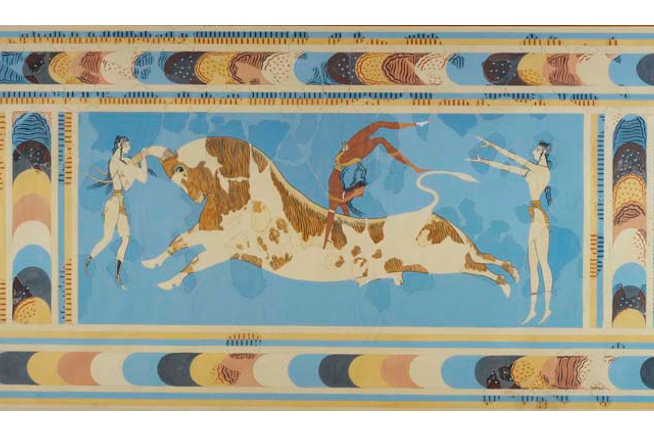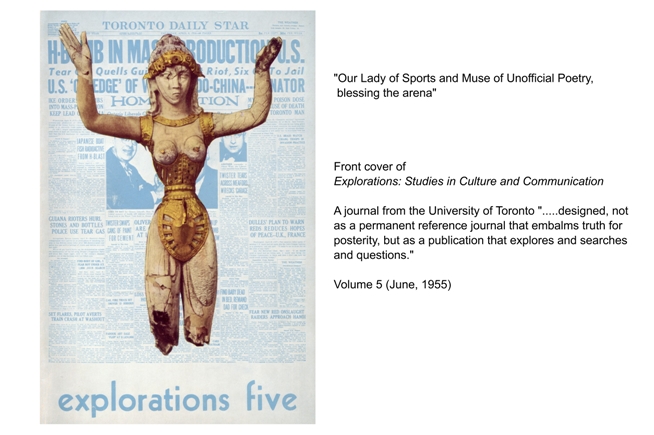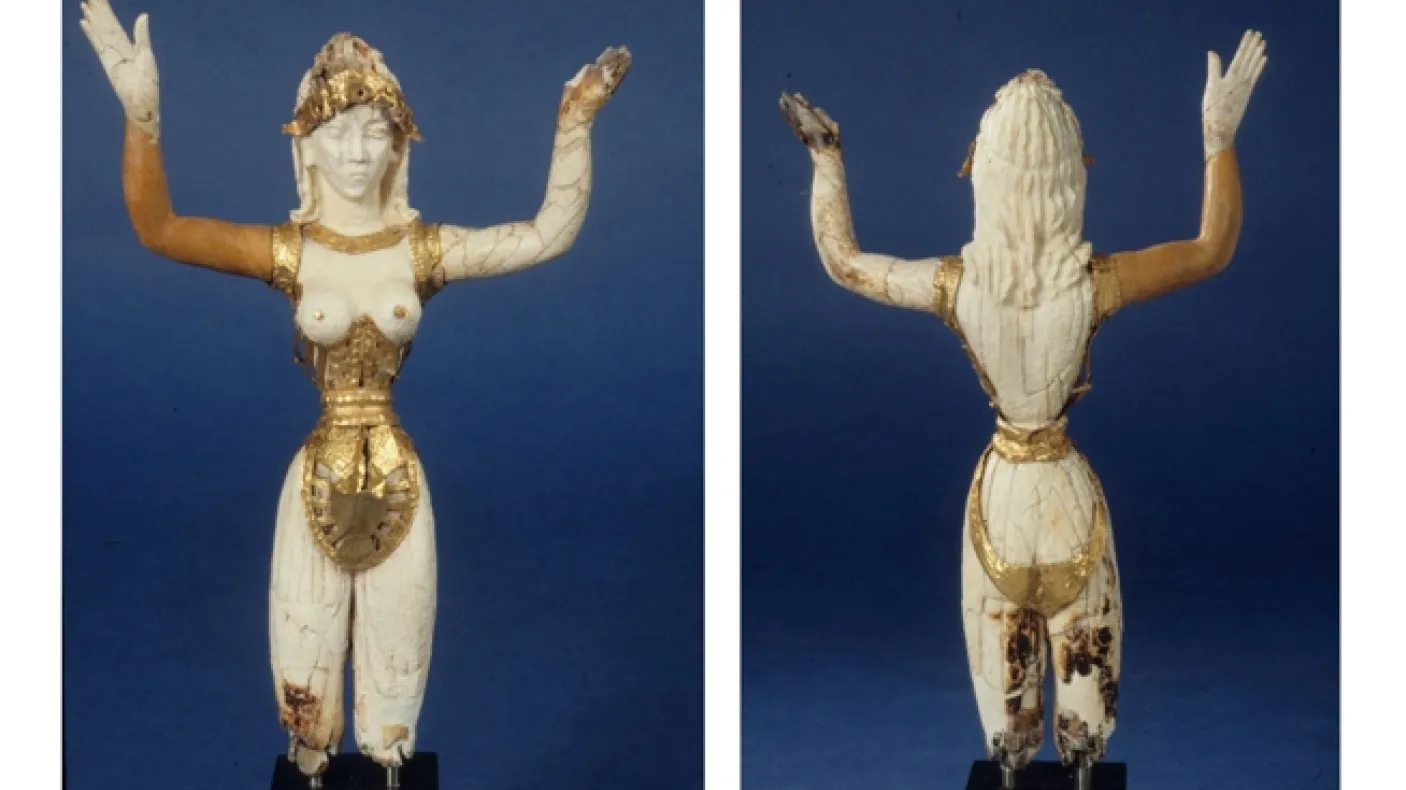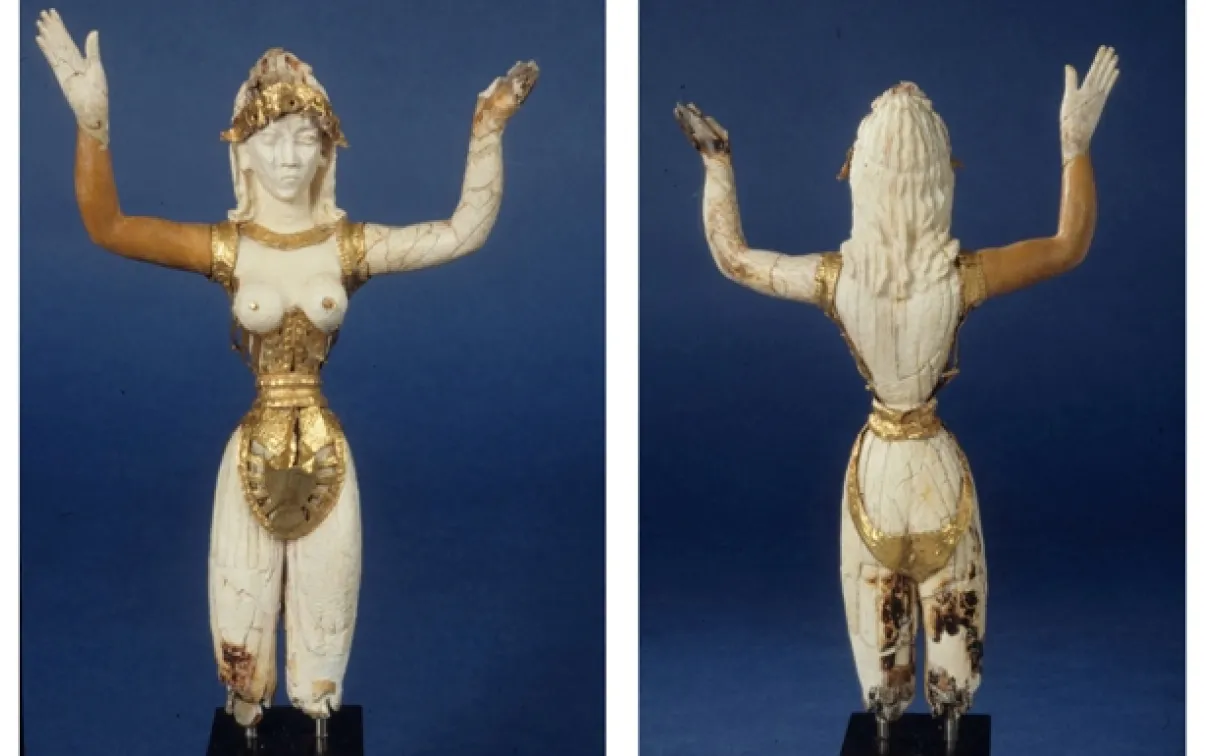The 'Goddess' and the Museum: "What's in a name?"
Published
Categories
Author

Blog Post
Here I continue the story of an icon of the Royal Ontario Museum (ROM) collection: the ivory and gold female figurine–ROM 931.21.1. For further information see the ‘Minoan’ Ivory Goddess Research Project.
In my last two articles about the ‘Goddess’ in the Museum (The Early Years and Museum Attitudes) I’ve discussed the history of the ROM figurine from the 1930s to the present. Here I want to reflect on the changing meanings that she has come to embody over those years. In the decades since she appeared, the figurine has been labelled in very different ways, which has effectively created several different, sometimes conflicting, identities for her. With each new incarnation she has sparked new interest and attracted a new audience.
A Piece of the Minoan Past
When the figurine was first bought in 1931 it was believed to be an antiquity that dated to the Middle Minoan III (early Neopalatial) period of the Aegean Bronze Age, around 1600 BCE. At the time objects from this period of antiquity were highly prized, since the Minoan civilisation had only been discovered a few decades earlier, when Arthur Evans began excavating at Knossos in 1900. This figurine was particularly special because it was a rare survival, finely carved out of ivory and unusually well-preserved. It represented a figure that had never before been seen, inspiring a deeper understanding of the Minoan culture. It was the combination of all these aspects that made the figurine a prize acquisition for the Museum.
This is the aspect which first made the figurine famous through publications such as The Palace of Minos, and this is also the aspect that has been so controversial when she was condemned as a 20th-century fake. It should be the easiest aspect to prove or disprove, since this is simply a matter of establishing an empirical date, but as you will have gathered, establishing a date is far from straightforward.
A Female Bull-Leaper
Her unusual costume identified this figurine as a bull-leaping acrobat, and this was how she was described by Charles Seltman (antiquities dealer and Lecturer at Cambridge University), both when he sold her to ROM in 1931, and in his respected book Women in Antiquity (1956), where he illustrated her with the label “Minoan Torera”. The wide belt and codpiece looked the same as those worn by bull-leaping acrobats (usually men) known from several Minoan images on cups, wall-painting and statuettes. The best known of these is the Minoan Bull-Leaping Fresco from the ‘palace’ at Knossos (now in Heraklion museum, Crete).

The Bull-Leaping (‘Taureador’) Fresco. A Minoan wall-painting from the ‘palace’ of Knossos, reconstructed by Émile Gilliéron (père). This is a watercolour reproduction by Piet de Jong (ROM 938.66.1)
Photo: © ROM
This connection with bull-leaping inspired several early scholars to use a combination of Minoan remains and ethnographic parallels with other cultures to consider how the Minoan bull-leaping performance actually worked, what it signified, and where it took place.
But the ROM figurine was more than a simple bull-leaper. She was clearly female and her costume combined the bull-leaping outfit usually worn by men with a corset reminiscent of the bodices worn by women in other Minoan imagery. Arthur Evans had already decided that the white-skinned figures in the Knossos Bull-Leaping fresco were not men (despite their costume), but young girls. Only the figure above the bull with reddish-brown skin was a male acrobat. Evans believed that the Minoans, following the convention found in ancient Egyptian art (and in later Greek art), represented women with white skin and men with dark and the full-breasted ROM figurine seemed to confirm the existence of female bull-leapers.
Evans’ identification of girls in the Bull-Leaping Fresco has been questioned – particularly since it was heavily restored by Émile Gilliéron (père). But it has also been widely accepted, and used as evidence to show the female equality in Minoan society. This has proved attractive in feminist debate, and the consideration of conceptions of gender-roles in Bronze Age Crete is an avenue of research that has been explored recently. Another related research-area is that of Minoan costume and dress, and the idea that Minoan girls were cross-dressing, wearing male codpieces, has been particularly popular.
A Minoan Goddess
It was Sir Arthur Evans who first declared the figurine to be a goddess, and named her “Our Lady of the Sports”. He believed that although she was dressed as a bull-leaper, physically she could not have been an athlete, and so must be the “patroness of the bull-leaping arena”. As goddess of the bull-leaping ritual, he believed she was a particular aspect of the Cretan Great Mother Goddess, whom he had already identified from other Cretan artefacts. Perhaps the best known of these representations of the Great Mother Goddess is the Minoan Snake Goddess, known from a faience figurine, now in Heraklion Museum, that Evans discovered in 1903 while excavating the ‘Temple Repositories’ at Knossos.
The importance of the Minoan Mother Goddess has appeared in all standard books on Bronze Age religion, and the ROM ‘goddess’ has also been used to support the theory that Minoan bull-leaping was a religious ritual in honour of the goddess. The Greek myth of the Minotaur has been interpreted as a reference to this religious performance transmitted through the ages.
However, as well as the Great Mother Goddess, many scholars have seen the existence of a youthful male god in the religion of the Minoans. Evans believed that the Minoan Mother Goddess and youthful Boy God were a precursor of this mother-son pairing in other religious beliefs, including the Christian Virgin Mary and her son Jesus. This perceived influence on Christianity may explain why he chose the title “Our Lady of the Sports”, which has strong Catholic overtones, despite not being a Catholic himself.
As well as being an important part of Minoan religion, “Our Lady of the Sports’ has also been seen as a contemporary pagan Great Mother Goddess, and has attracted a following among New Age spiritualists.
A Local Heroine
She has even been taken as something of a symbol of Toronto, such as when she appeared on the front cover of the 1955 issue of a University of Toronto journal called Explorations as “Mother Goddess, Our Lady of the Sports and Muse of Unofficial Poetry blessing the arena”.

A 20th Century Fake
Of course, she has attracted most interest as a modern fake. The enthusiasm to show that museums and experts have been ‘duped’ is one reason for this. As Currelly noted when the media first started the suggestion that the ROM goddess might be fake in 1935:
“I am sorry to say that a certain number of people have been getting themselves into the press by attacking objects in the larger museums…”
letter from C.T. Currelly to Dr L J Simpson, Ontario Minister of Education, 6th November, 1935
Exposing of the figurine itself as a fake has also been attractive because of the detective story that it reveals, and unravelling the story in the academic and public arena has made people’s careers. As well as the journal articles already discussed in my last article, the ROM figurine has appeared in a book by K. Lapatin (Mysteries of the Snake Goddess: Art, desire and forging of history, 2002), and in a television documentary featuring archaeologist Sandy McGillivray (The Secret of the Snake Goddess, 2007). In 2012 she was included in a temporary display of ROM Greek and Roman fakes. Indeed, this whole research project has been based on the idea that, whether or not she is fake, she still has a fascinating story that deserves to be told.
If she is a 20th-century fake, she is a skilful creation that would take a lot of work, and she is valuable as evidence for tastes and fashions in collecting in the early 20th century. Today, creating fake antiquities is a lucrative business, but this figurine shows that even a century ago the demand for owning Minoan antiquities still generated enough money to make faking worthwhile. It is striking that Minoan antiquities, rather than antiquities of other periods, were particularly in demand at this time, due to the work of Sir Arthur Evans and the discoveries made on Crete in the early years of the 20th century. I will highlight the influence that the discovery of the Minoan civilisation had on fashions in early 20th-century art and design in my article The Minoans Created.
It’s amazing to see how many different ways a tiny artefact, which may not even be genuinely ancient, has inspired generations of people with different ideas. Will this 2013 research project see her being re-incarnated?
Did you see her while she was on display? What did she mean to you? Does she have any other ‘personalities’ that I haven’t mentioned here? Let me know by leaving a comment.
Further Reading
C.L. Cooper (Kate Cooper), 'Biography of the Bull-Leaper: A 'Minoan' Ivory Figurine and Collecting Antiquity', in Cooper C.L. (ed) New Approaches to Ancient Material Culture in the Greek & Roman World (Leiden: Brill, MGR 27, 2021). doi:10.1163/9789004440753_005
A. Evans, The Palace of Minos: a comparative account of the successive stages of the early Cretan civilization as illustrated by the discoveries at Knossos. Volume IV: Part I (London: Macmillan and co, 1935). Pages 19-48.


